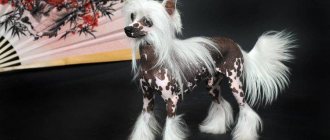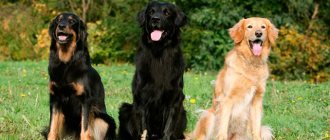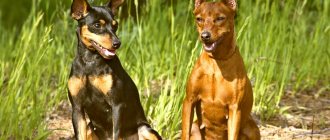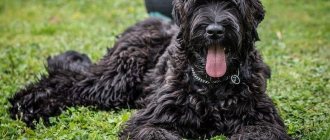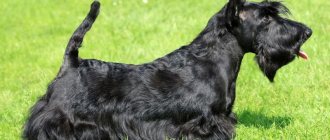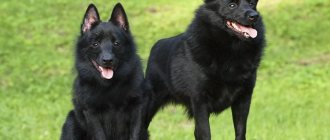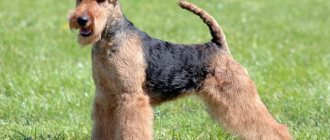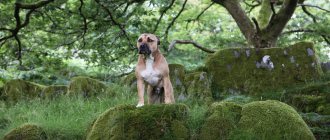Brief characteristics of the dog
Other possible names: Vlaamse Koehond, Bouvier de Flanders, Flanders Cattle Dog, Bouvier de Ruler, Picard, Vuilbaard, Bootes. Adult height: 56-71 cm. Weight: 27-54 kg. Characteristic color: black, red, gray, brindle, white, often black with red spots. Coat length: medium length, wavy. Life expectancy: 9-11 years. Advantages of the breed: loyal, intelligent, loves children, balanced, calm, obedient, does not bark over trifles. Difficulties of the breed: likes to dominate, not suitable for novice dog breeders, requires coat care. Average price: from $400.
History of the origin of the breed
The Bouvier des Flandres, like other breeds that were not purposefully bred, has several versions of its origin. But they all boil down to the fact that the homeland of dogs is the medieval county of Flanders, which is located on the border of Belgium and France. Since it existed in the 9th-14th centuries, the version about the origin of the breed back in the 12th century sounds more plausible. This happened thanks to the monks of Ter Duinen Abbey, who crossed Deerhounds and Irish Wolfhounds or Beaucerons. Subsequently, this mixture became the ancestor of many breeds.
According to another version, Bouviers appeared in the 16th-18th centuries and have the genes of Laekenois, Briard and Dutch Longhaired Shepherd. The official date in the history of the breed can be called 1894, when its first written description appeared by the Belgian professor A. Reul. In 1910, Bouviers took part for the first time at an exhibition in Brussels, and in 1912 their first standard was published, updated in 1923. During the First World War, some of the dogs were exported to Germany and subsequently took a direct part in the formation of the Giant Schnauzer. The name "Bouvier des Flandres" was assigned to the breed only in 1928. And in 1937, adjustments were made.
At the same time, French breeders insisted on a light color for Bouviers, while Belgian breeders, on the contrary, wanted to see them only in black. Their disputes were interrupted by the Second World War, during which many large breed dogs died because they were actively used as orderlies and for delivering weapons and food. Bouviers received worldwide recognition in 1965 thanks to the International Federation of Cynologists (FIC). The final standard was approved in 1969. The Bouvier des Flanders is most popular in France, Holland and the Netherlands, as well as in Italy, England, Sweden, Spain, Denmark and Germany. In other countries it is little distributed or completely unknown.
History of the origin of the Bouvier des Flanders
Perhaps the emergence of the Bouvier breed can be called the most confusing of all stories of canine origins. According to various testimonies, Belgium, France, and the Netherlands are considered the birthplace of this breed. But it would be more correct, apparently, to talk about Flemish soil, on the territory of which all these states are located.
Purebred dogs, as they are understood today, practically did not exist until the 17th century. There were quite a lot of working dogs, and they can even be considered more or less purebred, but to improve working qualities, regular interbreeding was carried out.
The first clubs began to be created by breeders of English Foxhounds, and dog shows became a new fashion in Europe. The first canine communities appeared, and by 1890 the bulk of herding dogs already had their own standards. The dog magazines of that year contain descriptions of an unusual breed of cattle dog living in Flanders. With the help of these animals, cattle were driven to markets and from one pasture to another.
The “duties” of such dogs included monitoring the livestock, they did not allow them to wander, they barked and even bit the lagging and disobedient animals. In their homeland, Bouviers were simply irreplaceable, but outside its borders almost nothing was known about the dog. British writer Maria Rame published The Dog of Flanders in 1872, which became a classic in the USA, England and Japan.
Since initially these dogs were kept by the Dutch-speaking peoples, who gave their four-legged helpers names according to their type and main activity. Therefore, if you translate the first names of the Bouvier, they will sound like “cow shepherd” and “dirty beard”. This is the basis for the version of the origin of the Bouvier from German and Dutch dogs.
The most common theory is that their ancestors were schnauzers, because these dogs were at the peak of their popularity back then. There is also an assumption that French dogs, which were brought to Flemish lands along trade routes, were involved in the appearance of the Bouvier.
According to other hypotheses, Bouvier dogs appeared by crossing the Beauceron and different types of griffins, as well as the result of the selection of English dogs with rough hair, such as the Irish Wolfhound or the Scottish Deerhoud, with shepherd dogs, which was carried out by the monks of the Ter Duinen monastery, where the first kennel was located. Each of these hypotheses may be close to reality, but the truth lies somewhere “in between.” Since Flemish farmers were active in trading and military activities, they had access to a large number of European breeds.
We advise you to read: American Bulldog Dog Breed
To obtain a universal shepherd dog, they crossed different dogs, as a result of which the Bouvier is a kind of “explosive mixture” of different breeds. In it you can find something from Airedale Terriers, Giant Schnauzers, German Boxers, various Collies, Griffons, Briards, Beaucerons and some other varieties.
The division of Belgium into two regions led to the use of Dutch in Flemish lands and French in Wallonia. Since 1890, the breed has become more in demand in Wallonia, where it was named in the French manner - Bouvier des Flandres (herding dog from Flanders).
The popularity of the French language then contributed to the fact that the name stuck. They made their debut at exhibitions in the Flemish lands in the first decades of the 20th century. And in 1914, the first breed standard was described in Belgium.
Soon after the official recognition of the breed, the First World War broke out. Until that moment, there were at least two variations of the breed. At the time of the German occupation of Belgian territory, only 20 such dogs were recorded. Many dogs became famous during wartime, but none of them managed the Bouvier des Flanders Representatives of this breed performed various functions in the army, they demonstrated courage and intelligence, becoming famous and popular.
But many dogs died at that time. And the destruction of the economy led to the inability to support them. The economic recovery process began in 1920, but the need for cattle dogs disappeared with the development of the railroad. Despite the disappearance of the main occupation for these dogs, the owners still kept these versatile animals. And in 1922 the first breed club was created. In the next decade, the breed became in demand in all countries of Flanders. Over 1000 dogs are registered every year.
Of course, Bouviers also actively participated in World War II; many dogs died in battle. But for Belgium, these years turned out to be so difficult that the breed almost disappeared - there were no more than a hundred dogs. In the 50-60s, the breed was actively developing in America, and in 1980, even the American President Reagan acquired a dog of the Bouvier des Flandres breed. Now in Europe these dogs are involved in various jobs. They serve in the army, police, rescue service, customs and guard various objects.
Description of the Bouvier des Flandres breed
Representatives of the breed are strong, compactly built dogs. They have a short body covered with hard fur. One glance is enough to understand that this is a strong animal, devoid of clumsiness.
According to the standard, dogs are described as follows:
- The head is large, but proportional to the size of the dog, with a flat forehead, the clear lines of the head are emphasized by a luxurious mustache and beard. Between the eyes there is an inconspicuous, frontal groove. The raised brow ridges make the transition from the frontal bone to the muzzle look sharper than it really is.
- The eyes are oval, the iris is dark brown. The look is bold and decisive. The ears are set high and are sensitive to any movement. The ears can be cropped into small, pointed triangles.
- The dog's muzzle is quite wide, well filled, tapering towards the nose, with flat cheekbones and tightly fitting lips. The lobe is black, large, the nostrils are wide open. The mouth is equipped with a full set of strong, large, white teeth, the bite is correct, like a “scissors”.
- The neck is strong, covered with muscles, and widens towards the shoulders. If you look at the dog from the side, you will notice a graceful curve. The body is short, wide, tightly built, but not heavy.
- The chest is wide, descending to the elbow line. The ribs have a good bend and are long. The belly line is moderately tucked.
- Limbs . The front legs are equipped with elbows that fit tightly to the body and short, slightly sloping metacarpus. Placed evenly, parallel to each other, the bones are strong. The hindquarters are strong, well muscled, the hips are wide and strong. The lower leg is of medium length, the metatarsals are shortened, and there is a noticeable plumb line. The paws are round, the toes are long, curved, compressed into a tight ball. The pads are dense, the claws are hard, pigmented black.
- The tail is located high, smoothly blending into the line of the spinal column. The cut is short, leaving only 2-3 vertebrae.
The height of males is 62-68 cm, females vary from 59 to 65 cm, average figures are considered ideal. Shepherds move freely and confidently.
Bouvier des Flandres - description of the breed
The Bouvier des Flanders breed was developed in the 15th and 16th centuries and descended from Spanish dogs that were brought to Flanders by conquistadors. At first, the dogs did not have their own official name and various nicknames were invented for them.
NOTE! The official name of the breed, “Bouvier des Flandres,” arose only in the 20th century.
Appearance of dogs
Dogs of the Bouvier des Flandres breed are quite large and strong with well-developed muscles and strong bones. The height at the withers of these dogs is approximately 65-67 cm, regardless of what gender they are. The body weight of males exceeds the body weight of females by 1.5-2 times.
The build of these dogs is quite compact, square in shape. The legs are strong and straight, also muscular. The tail of these dogs must be docked, leaving only 1-2 vertebrae.
The head of the Bouvier des Flandres is large and elongated, the jaws are well developed and powerful. The forehead of these dogs is wide and high. The triangular ears are set high and hang to the sides. The eyes are not visible from afar, as they are covered with fur. The expression of the eyes is calm and intelligent. The lips and nose are painted black as standard; other colors and spots are not allowed.
Bouvier des Flanders wool
The main distinguishing feature of the Bouvier des Flandres dogs is their coat. It is very thick and forms strange combs that are most noticeable on the head, neck and chest. When you look at this dog, it seems that it has eyebrows, mustaches and a beard. These large combs make the dog look unkempt, although this is not usually the case. The rest of the body has fur of uniform length and thickness.
The coat color of the Bouvier des Flanders can vary according to the standard. The most common coat color is black with some graying. In addition, there are colors of gray, white, fawn and even brindle. According to the standard, there should be no spots on the body, therefore such dogs are not allowed to compete and show.
CHARACTER
The Bouvier des Flandres personality is similar to that of other working breeds, although they are calmer. These dogs love people very much, most are incredibly attached to their family. When kept in an enclosure they suffer greatly; they need to live in a house and be part of a family. Known for his loyalty, the Bouvier des Flandres follows his family everywhere, but this is also a problem as he suffers greatly when separated.
They rarely demonstrate their love, preferring to express emotions in moderation. But, even with those they adore, they remain dominant and these dogs are not recommended for beginners.
After World War I, they were kept as bodyguards and military dogs, which contributed to the emergence of a very strong protective instinct. Suspicion of strangers is in their blood and very few dogs treat strangers warmly. They are not aggressive, but protective and, if raised correctly, quite polite. Socialization is very important because without it they can be aggressive.
Sensitive, they can be excellent watchmen, warning strangers with loud and frightening barks. The Bouvier des Flanders is a dog that protects its own and will always stand between danger and its loved ones. They prefer to scare the enemy rather than immediately attack and take threatening poses to drive him away. But, if they need to use force, they don’t hesitate and attack, no matter who opposes them.
They have a good reputation with children. Especially if a child has grown up in front of a dog, then they are very kind and become best friends. Like other breeds, if the dog is unfamiliar with children in general, the reaction may be unpredictable.
But they are not friends with animals and dogs. Almost all are extremely dominant and do not back down from a challenge. Aggression towards same-sex animals is especially strong and both sexes are predisposed to it. Ideally, keep only one Bouvier, maximum with the opposite sex.
Socialization helps reduce manifestations, but does not eliminate them. In addition, these are herding dogs and they instinctively nip the legs of those who do not obey them. The attitude towards other animals is no better; they can attack and kill them. Some are able to live with domestic cats if they have known them since childhood, some are not.
Very intelligent and eager to please their owners, Bouviers des Flandres are excellent to train. They are able to perform in obedience and agility, and learn everything in the world. They say that once a Bouvier remembers something, it never forgets.
However, for many, training will be difficult. These dogs are very dominant and will not blindly obey orders. If they don’t consider a person a leader, then you won’t get obedience. This means that in a relationship you should always take a leadership position, and training should begin as early as possible.
Like other herding dogs, the Bouvier des Flandres needs high activity and daily exercise. Without them, he will develop behavioral problems, destructiveness, and hyperactivity. However, they are much less energetic than the same border collies, and most city dwellers are able to satisfy their demands.
History of the breed
The first mention of the Bouvier occurred in the middle of the 16th century, in French literature. According to the chronicles, this breed was bred by monks who lived in the south of France - they used these giants instead of traction horses, and also to guard monasteries. It is believed that the Bouvier is the result of crossing an Irish wolfhound, greyhounds and a deerhound (the mentioned monks hunted for this), however, it is certain that genes from other breeds are present in the blood of the Bouvier.
The very first breeds were distinguished by comparative simplicity and some sloppiness. Later, this breed began to be crossed with breeds that had coarse, hard hair - and the result was a Bouvier with a beautiful thick coat, which retained its appearance.
The First and Second World Wars caused great harm to the Bouvier gene pool. These good-natured dogs were mercilessly used as draft horses - they took wounded soldiers from the battlefield, delivered provisions and ammunition. Many individuals died as a result of excessive physical labor, as well as due to gunshot wounds - this significantly reduced the gene pool of this breed.
The first Bouviers were sent to an international dog show in Brussels only in the middle of the twentieth century, where this breed received well-deserved recognition from the French Society of Canine Breeders. According to the international standard, the Bouvier retains the classification of a herding dog, which has access to various working tests.
The main purpose
As you can see even from the photo, the Bouvier des Flanders is a large, powerful dog. She is strong and strong, knows how to be decisive and subordinate. Her character is characterized by balance and calmness. Thanks to all these features, the Bouvier has been used before and now to catch criminals, as a guide dog, as a security guard, protector and reliable bodyguard. The animal is ideal for those who want to have a reliable, strong and fearless assistant in the house.
The animal is easy to train, gets along well with children, does not require special care and gets along well both in a country house and in an apartment.
The Bouvier des Flandres has a rather intimidating appearance, but at the same time its character is distinguished by its balance and calmness. He is an ideal pet: cheerful, obedient, moderately playful. A dog will be calm towards other pets if it is properly socialized from childhood.
These animals are very smart, have a stable psyche, fearless and strong. With proper training and upbringing, you will get a wonderful pet and at the same time a formidable guard.
Maintenance and care
The Flanders Bouvier is an unpretentious dog, eats relatively little, hardly gets sick, and can live outside even in cold weather. Grooming efforts should be concentrated on the coat. It is advisable to trim the Bouvier of Flanders once every six months. It is important to accustom your pet to this procedure from childhood, since an adult dog will not allow a stranger to approach itself. During trimming, a little grooming is acceptable, but only to emphasize the advantages, to refine the beard, mustache and eyebrows. At home, it is enough to comb the wool 1-2 times a week. The Bouvier of Flanders usually does not have problems with the eyes and ears, but their condition must be strictly monitored. Don’t forget that your pet’s beard and mustache should be wiped after eating and drinking water. You may not be able to keep track of how your dog drinks, but food particles stuck in the beard are guaranteed to lead to skin inflammation. Note! Very rarely, representatives of the breed experience abnormal eyelash growth, which can be overlooked under thick eyebrows. The dog's eyes should be clear, shiny, without redness, otherwise you need to consult a doctor.
Care and maintenance
In everyday life, the Bouvier des Flandres is unpretentious. He feels good both in a city apartment and in a private house. For a dog's coarse fur, it is enough to brush it once a week, trim it and cut it once every few months. It is necessary to accustom Bouviers to hygiene procedures from puppyhood, so that later you do not have to fight with a formidable beast.
The Bouvier des Flandres should be bathed only as needed. Don't forget to also clean your dog's ears and teeth, and monitor the condition of his nails. After feeding and walking, wipe the Bouvier's face with a damp cloth to remove any remaining food and dirt brought from the street.
You can feed your Bouvier des Flandres with both dry ready-made food and home-cooked natural food. No digestive difficulties were noted in these dogs. The main thing is not to forget that nutrition should be complete and balanced.
The Bouvier des Flandres needs daily exercise; without it, it becomes bored and loses shape.
Health
Bouvier des Flandres puppies take a long time to grow up, one might say, to mature. Like other large dogs, a pet can be considered an adult by the age of 2–3 years. The average life expectancy of representatives of the breed ranges from 10 to 12 years. Such a short period of time may confuse a potential pet, but giant breeds rarely live longer due to severe stress on the skeleton and heart.
Important! Flanders Bouvier males are allowed to breed at the age of 2 years, females from 3 years old. By the way, due to their size, females come into heat once a year. Puppies gain weight very quickly, which creates certain risks of improper bone formation. These problems are solved by balanced feeding, vitamin supplements, strict control and moderate physical activity. When properly raised, representatives of the breed almost never get sick and remain active until old age. Some dogs experience age-related and hereditary joint dysplasia, heart defects and arthritis.
Origin story
Dogs of the Bouvier des Flandres breed have been around for many centuries. These bear-like dogs appeared back in the 12th century. They took root in the territory of Flanders (part of Belgium and France) and were improved over the centuries to suit specific natural conditions. These were the dogs of farmers and cattle breeders.
During World War II, dogs selflessly helped partisans and soldiers. The breed was recognized in 1955. And the final standard was formed in 1965. Another name is “cow dog”, “dirty beard”.
Raising a Bouvier des Flandres puppy
You have a Bouvier des Flanders puppy
. Where to start raising him? It's simple, first, stop your puppy from jumping on your feet and chewing on your things. This can be done very simply; the puppy will be weaned off toys from gnawing, but it’s more difficult to wean the puppy off from jumping. First of all, pretend that you are ignoring the dog. Don't look or talk to her when she jumps on you. The puppy will understand that this game is not interesting to you and over time will stop pestering you.
Raising a Bouvier des Flandres
definitely necessary. These are guard dogs, so if you do not educate and train them, you will end up with a large and completely uncontrollable dog. To begin with, you should accustom your pet to the place. Then be sure to take your dog through a general training course. This is mandatory because the dog must be absolutely controllable.
Once you have mastered the general training course with your pet, you can move on to special courses.
These dogs make excellent guards and bodyguards. They say that training these dogs requires a steady hand with a suede glove. These dogs are quite easy to train, but they have one unpleasant character trait. They are slightly inclined to independence. Therefore, subordinating the dog to your will is the first task of education.
Where to buy a Bouvier des Flandres puppy?
In our country, these dogs are not very popular, so you won’t be able to easily find a kennel or breeder. Modern technologies will come to your aid in this matter. As you may have guessed, we are talking about the Internet. Here you can find information about Bouvier des Flanders kennels
on the territory of the Russian Federation and about private breeders.
There are several clubs for lovers of these dogs in the country, so information and a puppy are available if desired. Buy a Bouvier des Flandres puppy
you can for about 20-25,000 rubles, provided that you buy the dog second-hand.
Bouvier des Flandres price
in the nursery it will be slightly higher, and nothing can be done about it. In a kennel, such dogs cost about 30-40,000 rubles, depending on the name of the kennel and the puppy’s parents.
So, the Bouvier des Flandres is a very interesting and rare dog in our area. Moreover, puppies of this dog breed are not very expensive. Apparently this is due to the unpopularity of the breed. These dogs are very loyal to their owner and are easy to train. These dogs are suitable for people who do not lead a sedentary lifestyle and have a large family. Dogs of the Bouvier des Flandres breed
They just love communication.
How to choose a Bouvier des Flandres puppy
A puppy of this breed must be chosen carefully to avoid problems in the future. To do this, it is necessary not only to understand the breed standards, but also to know the pedigree of each specific dog. It is best to buy a puppy from a trusted and reliable breeder who has all the necessary certificates and also treats animals correctly. The cost of one puppy can vary from 200 to 1000 dollars depending on its pedigree.
When choosing a puppy, you need to carefully examine it for physical defects:
- The dog's eyes should be clean and clear (without a cloudy coating).
- All paws are correctly and proportionally developed.
- The coat should be thick and clean.
- The puppy should be fairly active and eat well.
- Observe his behavior - how he behaves with his mother or with his brothers.
The puppy should not be too aggressive or too apathetic, as difficulties may arise in the future when training. The dog should be observed for several days to see how often he eats, how active he is, and whether he shows strong aggression towards humans and other dogs. Take your time and you will be able to choose the best puppy.
Bouvier des Flanders: characteristics of the dog breed, photo
Nutrition
Many breeders feed their pupils dry food; they believe that special ready-made food contains all the necessary nutrients, vitamins and microelements, and is also well absorbed by the dog’s body. If the food is of high quality, without chemicals, dyes and preservatives, and not lower than the “premium” class, dogs will not experience digestive difficulties. In addition, this type of feeding does not require additional vitamin and mineral supplements. The feeding regimen is important.
At first, puppies need to be fed about five times a day; from six to ten months, puppies are fed four to three times a day; from ten to twelve months, 2 times a day. Starting from 1 year of age, the dog is switched to one meal a day. If you decide to feed your dog natural food, remember that it must be fresh, high quality and without chemical additives. The main product is meat. Fermented milk products, fish and offal are also useful. Don't forget about vegetables and fruits. You cannot feed your pet sweets, pickled and smoked foods, semi-finished products, canned food, cereals (except buckwheat, rice and oatmeal), potatoes, and tubular bones. Food does not need to enhance its taste; it does not need to be salted or spiced.
Training, training
To train this dog, it is best to use the services of a professional dog trainer.
However, if you decide to raise your pet yourself, then you should remember a few rules for training these dogs. The Bouvier des Flandres needs the owner's firmness and confidence in his actions. The dog is easy to train, but can sometimes be stubborn. You must be persistent, patient and strict. Bouvier must understand who is boss. Otherwise it will be quite difficult with him. If the dog grows up in an urban environment, provide it with a lot of physical activity, as this is a working dog that needs mental and physical activity. The Bouvier des Flandres is a shepherd, which means it needs a lot of time in the fresh air. Bouvier is a wonderful friend who loves an active lifestyle in any weather. If you need a bodyguard or tracker, this dog would be a good choice. With him you will not be afraid for your children and yourself, because the Bouvier will always be able to protect both you and himself.
Mating
In a litter, Bouvier des Flandres bitches give birth to 6 to 9 puppies. Pregnancy lasts from 63 to 72 days. Signs appear in the third week. On days 21–22, small hard round lumps can be detected on both sides of the dog’s abdomen using your fingers, which can be palpated until day 35. With the onset of the fifth week, the bitch’s mammary glands enlarge, and in the sixth week, the belly enlarges. A few days before giving birth, it goes down.
A pregnant dog needs a lot of protein. During the first month, the bitch is fed as usual. Further, her diet is based on meat, dairy products, eggs, and fish. The amount of food is doubled.
Important! The bitch should not be overfed. If she gains excess weight, it will complicate the birth process. When feeding with industrial formulas, switch the bitch to a special formula for pregnant women.
In the first half of pregnancy, there is no need to change your walking routine. Then, as the belly increases, the dog itself will refuse to walk for a long time. The bitch should not go up and down stairs or make sudden movements. Don't let her sit on a cold floor.
You need to take care of the place for childbirth in advance. Prepare for this purpose a box corresponding to the size of the dog, a puppy box, diapers, a heating pad, thread, scissors, and disinfectant.
With the onset of the last days of pregnancy, do not leave the bitch unattended. Before birth approaches, she becomes restless, whines, scratches the floor, tears up the bedding, refuses food, and spins around in one place. The dog's body temperature drops to 36.5–37 °C. She begins to have mucous discharge. At the same time, the bitch takes a lying position, presses her back against the box and rests her paws against the wall.
The first puppy is often the largest, so its birth is more difficult than the birth of other cubs. They usually come out with their heads forward and their backs up. The puppy appears in the amniotic sac, which needs to be torn. Then you should remove the baby and cut the umbilical cord at a distance of 2-3 cm. But if the dog wants to do this on its own, there is no need to interfere with it.
If bleeding occurs, tie the umbilical cord with a thread. Wipe the puppy with a napkin and place it next to the bitch. She will begin to lick the baby, which will help stimulate his blood circulation and breathing. After the puppy is born, the placenta is expelled. If the afterbirth does not come out, you must contact a veterinarian, otherwise the dog will die. The bitch also requires medical attention if the interval between the birth of puppies exceeds 2 hours.
Pregnancy and childbirth
Pregnancy passes without any difficulties
In a litter, Bouvier des Flandres bitches give birth to 6 to 9 puppies. Pregnancy lasts from 63 to 72 days. Signs appear in the third week. On days 21–22, small hard round lumps can be detected on both sides of the dog’s abdomen using your fingers, which can be palpated until day 35. With the onset of the fifth week, the bitch’s mammary glands enlarge, and in the sixth week, the belly enlarges. A few days before giving birth, it goes down.
A pregnant dog needs a lot of protein. During the first month, the bitch is fed as usual. Further, her diet is based on meat, dairy products, eggs, and fish. The amount of food is doubled.
Important! The bitch should not be overfed. If she gains excess weight, it will complicate the birth process. When feeding with industrial formulas, switch the bitch to a special formula for pregnant women.
In the first half of pregnancy, there is no need to change your walking routine. Then, as the belly increases, the dog itself will refuse to walk for a long time. The bitch should not go up and down stairs or make sudden movements. Don't let her sit on a cold floor.
You need to take care of the place for childbirth in advance. Prepare for this purpose a box corresponding to the size of the dog, a puppy box, diapers, a heating pad, thread, scissors, and disinfectant.
With the onset of the last days of pregnancy, do not leave the bitch unattended. Before birth approaches, she becomes restless, whines, scratches the floor, tears up the bedding, refuses food, and spins around in one place. The dog's body temperature drops to 36.5–37 °C. She begins to have mucous discharge. At the same time, the bitch takes a lying position, presses her back against the box and rests her paws against the wall.
The first puppy is often the largest, so its birth is more difficult than the birth of other cubs. They usually come out with their heads forward and their backs up. The puppy appears in the amniotic sac, which needs to be torn. Then you should remove the baby and cut the umbilical cord at a distance of 2-3 cm. But if the dog wants to do this on its own, there is no need to interfere with it.
If bleeding occurs, tie the umbilical cord with a thread. Wipe the puppy with a napkin and place it next to the bitch. She will begin to lick the baby, which will help stimulate his blood circulation and breathing. After the puppy is born, the placenta is expelled. If the afterbirth does not come out, you must contact a veterinarian, otherwise the dog will die. The bitch also requires medical attention if the interval between the birth of puppies exceeds 2 hours.
Characteristic diseases of the breed and vaccination schedule
Diseases that are common in Bouviers de Flanders include hip dysplasia and volvulus. But they rarely have problems with their well-being; they are a fairly healthy and hardy breed. Vaccination will help protect your pet from infectious diseases. Timely vaccinations help prevent the occurrence of rabies, parvovirus enteritis, canine distemper, parainfluenza, Lyme disease, leptospirosis, and coronavirus.
Vaccination is carried out in the following order:
- at 6–8 weeks of the puppy’s life;
- after 2 weeks after the first vaccination;
- at the age of 6 months;
- every year.
The dog must be dewormed 10–14 days before vaccination. The animal is given one of the following drugs: Drontal Junior, Dirofen, MilbeMax. Even small puppies should undergo this procedure, as infection can occur in utero or through feeding through milk.
It takes some time for the immune defense to develop. Therefore, for two weeks after vaccination, avoid contact of your pet with other animals.
FINNISH SPITZ (FIN. SUOMENPYSTYKORVA, ENG. FINNISH SPITZ) HUNTING BREED OF DOG
FILA BRAZILEIRO (BRAZILIAN FILA, BRAZILIAN MASTIF, ENGLISH FILA BRASILEIRO)
THE PHARAOH HOG IS LEAN, MUSCULAR, GRACEFUL, FAST AND AGILITY
FRENCH BULLDOG WITH A FRIENDLY CHARACTER
Frequent problems and illnesses
The most common diseases of Bouvier des Flandres include:
- dysplasia of the hip and elbow joints;
- glaucoma;
- heart failure;
- diseases associated with the thyroid gland.
This breed of dog is one of those species in which the fewest hereditary diseases have been found. In addition to good health and an original exterior, the animals are distinguished by their impeccable service capabilities (pathfinders, watchmen and protectors). The Bouvier des Flandres is a Belgian bear with an ideal character who enjoys playing with children and is devoted to his household.
Dogs' paws sweat
It turns out that dogs sweat too. But while humans sweat through the skin all over their bodies, dogs sweat through their paws. You can verify this by watching your dog on a hot summer day. A characteristic symptom will be a salty odor, reminiscent of popcorn or corn chips.
Having a dog in the house can protect owners from asthma and colds
Research shows that children who lived in households with dogs had fewer allergies and were less likely to get sick than children who were raised in households without pets.
Dogs can detect cancer and other diseases
If a person has cancer, diabetes, or epilepsy, his dog may be the first to know about it. Research has shown that dogs can be trained to detect cancer in a specific organ, such as the lung, breast, skin, bladder and prostate. Scientists believe that dogs can smell even the faintest smell of malignant tumors.

